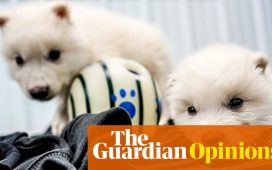Nearly 2m hectares of forests suitable for endangered koalas have been destroyed since the iconic species was declared a threatened species in 2011, according to analysis for Guardian Australia.
The scale of habitat destruction in Queensland and New South Wales – states in which the koala is formally recognised as being at risk of extinction – has continued despite political promises it would be protected.
Analysis by the Australian Conservation Foundation using state and federal government data found 1,964,200 hectares of koala habitat were cleared between 2012 and 2021, the latest year for which there was complete data.
The total amount of destroyed forest and bush covered an area larger than greater Sydney, taking in the Blue Mountains, the Illawarra, the southern highlands and the Goulburn and Shoalhaven regions.
It is more than 10 times larger than the area the NSW government is assessing for a possible “great koala national park”. But most of the cleared area – 81% – was in Queensland.
About three-quarters of the lost forest is estimated to have been cleared for agriculture, to create cattle pasture and crop fields. The analysis found 13% was removed by the forestry industry and 5% for development of infrastructure, including mining. Just 4% was likely due to natural causes, such as bushfire and drought.
Nearly all of the forest destruction occurred on a small scale that did not require consideration under federal environment law. Less than 2% of it was approved by the federal environment minister.
Campaigners say it shows the national Environment Protection and Biodiversity Conservation Act – which the Albanese government promised to rewrite in this term before delaying its plans indefinitely – is deeply flawed.
Darcie Carruthers, an Australian Conservation Foundation nature campaigner, said: “It beggars belief that with nearly 2m hectares of potential koala habitat gone in just a decade, the federal government would continue to approve projects that bulldoze koalas’ homes. But that’s exactly what’s happening.”
A separate analysis by the foundation found that almost 3,000 hectares of potential koala habitat were approved for clearing in 2024.
Carruthers said the outsized contribution of the beef industry towards habitat loss showed “the food system can do much more for koalas”.
“There are solutions to make sure people, farms, koalas and the forests we all depend on can all thrive,” she said.
Gemma Plesman, a senior campaigner at Greenpeace Australia Pacific, said the data showed the “complete failure” of federal environment laws to protect “Australia’s most iconic” endangered species. “Every year koalas lose more of their home – mostly driven by beef production – and neither of our major parties have been able to stop the destruction,” she said.
Koalas in Queensland, NSW and the Australian Capita Territory were formally listed as being vulnerable to extinction in 2012. In 2022 the threat level was raised to endangered after scientists concluded that numbers were likely to have dropped by half over the previous 20 years.
after newsletter promotion
A more recent national project to better estimate the number of koalas suggested there are between 95,000 and 238,000 in the states where the species is considered endangered and between 129,000 and 286,000 in Victoria and South Australia.
The species faces a host of threats in addition to losing its habitat, including the climate crisis and disease. Dr Christine Hosking, a conservation scientist at the University of Queensland who has researched how the climate emergency will shrink the koala’s habitat, said the threat was “playing out now in real time”.
“Areas of New South Wales and Queensland have seen big reductions [in koala numbers] and that’s been down to protracted droughts and heatwaves,” she said. “Koala’s can’t thermoregulate above about 37C and we now get successive days above that [as well as] days over 40C in a row. They simply can’t survive.”
Hosking’s research shows that as temperatures rise the koala’s habitat in Queensland and NSW contracts eastward, pushing them into already developed areas where they face other risks such as vehicles and dog attacks.
A University of Sydney study in February on one of the country’s few chlamydia-free koala populations – located in south-western Sydney – found urban development had effectively isolated the population, leading to high levels of in-breeding that made the species more susceptible to disease.
“We’re losing koalas for complex reasons,” Hosking said. “Habitat loss is the No 1 threat because they’re so limited in what they can eat, but then you have roads, urbanisation, chlamydia and, of course, climate change.”
Prof Mathew Crowther, a conservation biologist and koala ecologist at the University of Sydney, said the marsupial’s specialised diet – eucalyptus leaves – put it in conflict with humans.
Eucalyptus trees that grow on flatter, more fertile soils generally produce leaves higher in nutrients and lower in toxins. But those flat, fertile soils are where humans like to settle and grow food. “Koalas and people want the same kind of land,” Crowther said.
He said national parks tended to be in more rugged country, which was not the koala’s preferred habitat. Many live outside national parks on private land.
“We need to make sure there’s enough habitat that is linked together, we need to make sure regrowth and plantings are allowed to happen and we have to give incentives for landholders,” he said.












